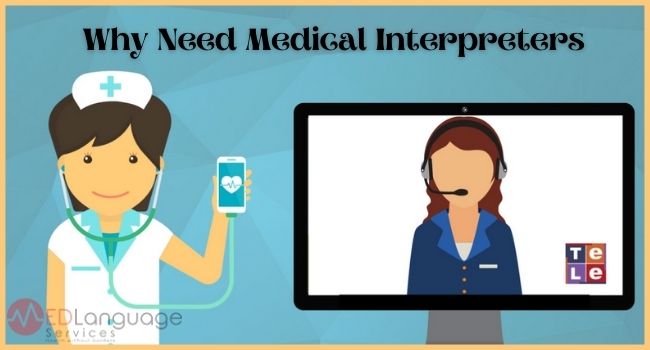
Imagine trying to ask a Japanese individual who only speaks and understands Japanese a question in English. Even if he knows a few essential English words, he’s still not going to understand what you’re saying. You can gesticulate all you want, but there won’t be any communication. Now, imagine that you were an American with an inflamed appendix in a Japanese hospital trying to explain your pain symptoms. You’ll end up frustrated, still in pain, and scared.
This scenario is one that many foreigners experience in hospitals in a new country. Even with the odd doctor or nurse who took Spanish in high school, these patients still have difficulty expressing their symptoms to their caregivers. The US is becoming more racially diverse, and so more than ever, medical care providers need the services of medical interpreters to make providing medical care feasible and easy.
Asides from keeping patients comfortable, why is it important to have medical interpreters? The following five reasons would highlight why every medical care provider should have interpreters on its payroll.
-
To Adequately Communicate Medical Procedures and Diagnoses to Patients
Patients have a right to know what medical procedures they need to undergo. In fact, informing patients of what a particular medical procedure would entail is part of the formal procedure.
This would not be an issue when the patient can speak the English language but, in a situation where the patient is a foreigner and has a limited understanding of the English Language, communication becomes a problem. Not all gestures and basic knowledge of a staff member can explain complicated medical procedures and terms.
Situations like this require the services of a professional medical translation to bridge the gap of communication so patients can fully understand their diagnoses and whatever medical procedure they have to undergo.
-
For Communication with Special Needs Patients
Special needs patients that are deaf or hard of hearing find it difficult to communicate their symptoms to a medical care provider who has limited to no knowledge of sign language. Hospitals and health care providers have to have a medical interpreter on the ground to help these patients communicate.
The ADA requires that hospitals provide their hearing-impaired patients with the following methods of communication:
- Oral interpreters
An oral interpreter can speak in a way that lip-readers can understand well. Doctors and nurses might be unable to speak in a way that allows the patient to read lips and would require an oral interpreter to communicate.
- Cued Speech Interpreters
Cued speech interpreters use hand codes called cues to represent speech sound. They also facilitate communication through gestures and body language. This type of communication is definitely not known by everyone apart from people trained specifically for it.
- Sign language Interpreters
Sign language is one of the most popular means of communication with hearing-impaired people. But despite its popularity, it isn’t known by everyone. A sign interpreter can facilitate communication between deaf patients and medical care providers.
- Computer-assisted real-time transcription
Known as CART, this language interpreter isn’t a person. It is a computer that transcribes in real-time what the doctor or nurse is saying. This is mostly for individuals who are hard of hearing.
Some patients might require one or more of these interpreters when communicating with their care providers.
-
To Provide Satisfactory Healthcare to Foreign Patients
Providing medical care goes beyond treating a particular ailment and monitoring vitals. It encompasses a lot of things, including comfort and communication. How easy was it for the patient to communicate their needs and symptoms? Were they able to do so without frustration? Was an interpreter on hand to ease communication? Did the patient understand the doctor’s diagnosis and treatment? Was the doctor able to understand and act accordingly?
To provide adequate healthcare, communication is vital. Both doctor and patient should be able to understand each other.
-
Medical Interpreters Help In the Emergency Room
The chaotic hustle and bustle atmosphere in the emergency room adequately mirrors the fast-paced beat of this wing in the hospital. Things happen fast in the emergency room, and there’s a need for doctors to act fast to stabilize patients such as accident victims who need immediate attention to save their lives. In the case of foreign patients who aren’t fluent English speakers, the doctor on call would require a medical interpreter to translate what the patient is saying to give adequate care.
In other cases where a patient comes in with a family member who doesn’t speak English, a medical interpreter should be available to facilitate communication between the medical caregiver, be it a doctor or nurse.
The results of having a medical interpreter include easing patients and keeping them calm. When a patient feels like they cannot communicate well with their care provider, they become agitated and lengthen the process and time of consultation. In an emergency, wasted time could have serious negative effects. Besides, a stress-free patient is always a good thing.
-
To Avoid Lawsuits
Federal law in the USA requires all hospitals to have a qualified medical interpreter. Not having one automatically puts the management of the hospital at risk of a lawsuit. And the penalties for this fall between a fine and loss of medical license.
Asides from this, if a medical care provider does not adequately explain medical procedures and diagnoses to patients, patients could sue. To avoid being on the bad side of the law, keep to the law and provide patients with an interpreter.
Medical interpreters have been relegated to the background, and now they are needed the most. Both patient and doctor need to understand each other. To facilitate this understanding, they would need to understand the other—cue in the medical interpreter. With a medical interpreter, patients and doctors are happy; the risk of malpractice is low, improved patient satisfaction, and fewer communication mistakes.



